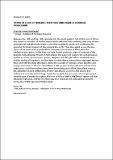Por favor, use este identificador para citar o enlazar a este item:
http://hdl.handle.net/10261/237810COMPARTIR / EXPORTAR:
 SHARE
BASE SHARE
BASE
|
|
| Visualizar otros formatos: MARC | Dublin Core | RDF | ORE | MODS | METS | DIDL | DATACITE | |

| Campo DC | Valor | Lengua/Idioma |
|---|---|---|
| dc.contributor.author | Torres Rodriguez, Jorge de | - |
| dc.date.accessioned | 2021-04-13T10:10:03Z | - |
| dc.date.available | 2021-04-13T10:10:03Z | - |
| dc.date.issued | 2020-08 | - |
| dc.identifier.citation | 26th EAA Virtual Annual Meeting (2020) | - |
| dc.identifier.uri | http://hdl.handle.net/10261/237810 | - |
| dc.description | Trabajo presentado en la 26th EAA Virtual Annual Meeting (European Association of Archaeologists), celebrada online del 24 al 30 de agosto de 2020. | - |
| dc.description.abstract | Between the 11th and the 16th centuries AD, the south-eastern half of the Horn of Africa was home to a number of Muslim states which extended their authority over very diverse geographical and ethnically regions, providing stability for trade and challenging the powerful Christian kingdom of Abyssinia to the north. They also acted as one the key actors of the international trade which connected the interior of Africa with the Mediterranean region, Middle East and Asia. Based on the six years of research of the Spanish Archaeological Mission in Somaliland, this paper will explore the archaeological evidences of the diverse ethnic groups, religions and lifestyles which inhabited these Muslim medieval kingdoms, and the ways in which these communities interacted among them and with the state structures. Using the example of nomads, urban dwellers and foreign merchants in western Somaliland, it will present an interpretation of how these interactions could have taken place, from the trading posts of the Somaliland coast to the agriculture-based settlements of inner Somaliland, as well as the elusive but widespread nomadic archaeology. It will also analyze the processes of emergency and consolidation of states throughout the Horn of Africa, both in the Somali region and the Ethiopian highlands, and the role they played in regional and international contexts during the Middle Ages and Modern Ages. | - |
| dc.language | eng | - |
| dc.rights | openAccess | - |
| dc.subject | Trade | - |
| dc.subject | State structures | - |
| dc.subject | Trading town | - |
| dc.subject | Nomads | - |
| dc.subject | Horn of Africa | - |
| dc.subject | Middle Ages | - |
| dc.title | Towns in a sea of nomads: territory and trade in medieval Somaliland | - |
| dc.type | actas de congreso | - |
| dc.date.updated | 2021-04-13T10:10:04Z | - |
| dc.relation.csic | Sí | - |
| dc.type.coar | http://purl.org/coar/resource_type/c_f744 | es_ES |
| item.fulltext | With Fulltext | - |
| item.openairecristype | http://purl.org/coar/resource_type/c_18cf | - |
| item.cerifentitytype | Publications | - |
| item.grantfulltext | open | - |
| item.openairetype | actas de congreso | - |
| Aparece en las colecciones: | (INCIPIT) Comunicaciones congresos | |
Ficheros en este ítem:
| Fichero | Descripción | Tamaño | Formato | |
|---|---|---|---|---|
| Towns_sea_nomads.pdf | 1,24 MB | Adobe PDF |  Visualizar/Abrir |
CORE Recommender
NOTA: Los ítems de Digital.CSIC están protegidos por copyright, con todos los derechos reservados, a menos que se indique lo contrario.
